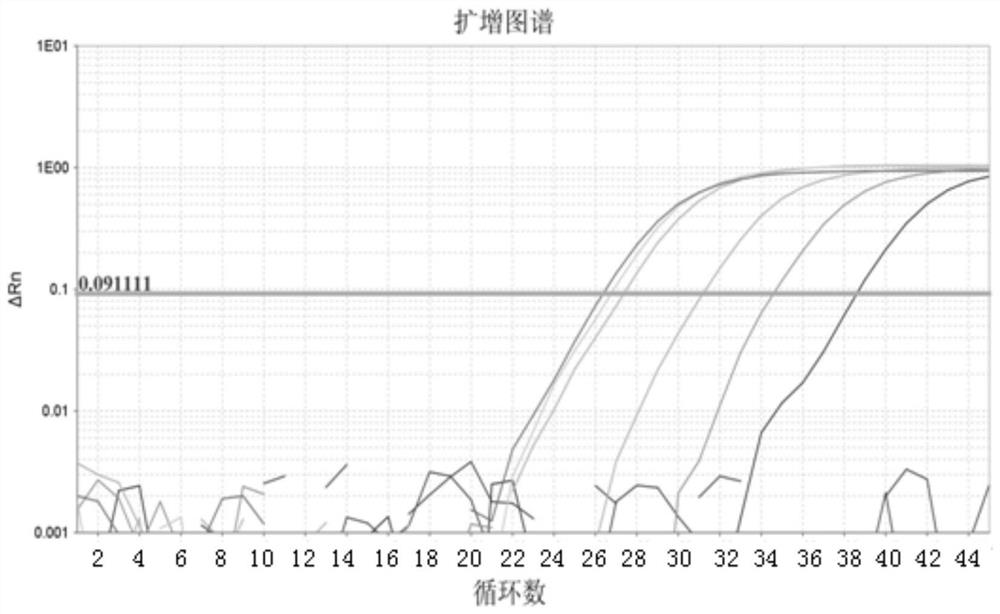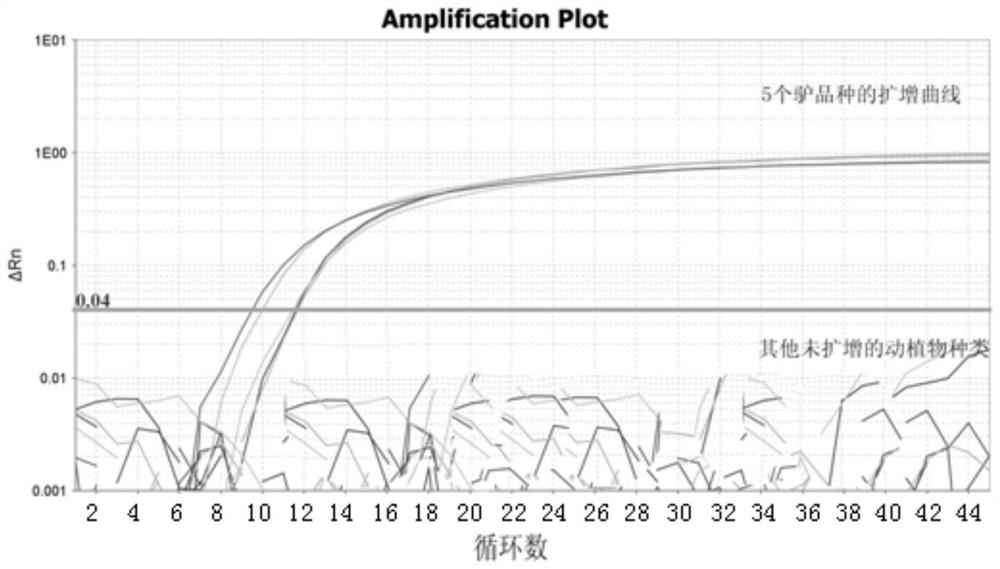Real-time fluorescent PCR detection method for donkey-derived components in food and feed
A real-time fluorescent, donkey-derived technology, applied in the field of bioengineering, to achieve the effects of good specificity, good intraspecific conservation, and wide application range
- Summary
- Abstract
- Description
- Claims
- Application Information
AI Technical Summary
Problems solved by technology
Method used
Image
Examples
Embodiment 1
[0037] The design of embodiment 1 primer pair and probe
[0038] (1) Design of the first set of primer probes
[0039] The donkey genome scaffold gene (GenBank: NW_014638576.1) was selected as the target gene to design primers and probes. First use NCBI to analyze the sequence and then use Applied Biosystems (ABI; Foster City, CA, USA) company's Primer Designed with Software version 3.0, the length of the amplified fragment for donkey-derived components is 95 bp (located in the nucleotide 581564-581658 interval), and the primer probe sequences are shown in Table 1.
[0040] Table 1 The first set of primer probe sequences
[0041]
[0042] (2) Design of the second set of primer probes
[0043] According to the primer probe design method, some fragments of the donkey genome scaffold gene (GenBank: NW_014638576.1) were selected to design primer pairs and probes. The length of the amplified fragment of donkey-derived components was 108 bp. The primer and probe sequences are...
Embodiment 2
[0052] The preparation of embodiment 2 samples, the extraction of DNA and real-time fluorescent PCR test
[0053] (1) Sample preparation
[0054] Buy fresh lean meat and other commercial meat products from slaughterhouses and supermarkets. They were chopped separately, dried in an oven (UFE500AO; Memeert, Germany) at 80°C for 72 hours, and then pulverized into ultrafine powders using a liquid nitrogen pulverizer (SPEX SamplePrep, USA).
[0055] (2) Extraction of DNA
[0056]Use phenol-chloroform DNA extraction method to extract 100 mg of sample: add 800 μl Tiangen lysate and 10 μl proteinase K, vortex and shake to mix, 65 ° C water bath for 60 minutes, add an equal volume of phenol-chloroform and centrifuge at 12000 rpm for 10 minutes, take The supernatant was purified once more with phenol-chloroform, and then 1 / 10 volume of 3M sodium acetate (pH 5.2) was added. Subsequently, two volumes of ice-bathed absolute ethanol was used for precipitation at -20°C for 30 min, and the...
Embodiment 3
[0059] The primer pair of embodiment 3 donkey-derived components and the sensitivity detection of probe
[0060] The genomic DNA of the donkey was extracted by the DNA extraction method in Example 2, and diluted into 40ng / μl, 20ng / μl, 10ng / μl, 1ng / μl, 0.1ng / μl, 0.01ng / μl, 0.001ng / μl and 0.0001 ng / μl, and then carry out real-time fluorescent PCR detection with the first set of primer probes and the second set of primer probes in Example 1, and the experiment was repeated 6 times. The result is as figure 1 and figure 2 shown.
[0061] figure 1 The results showed that in the 6 tests, amplification curves appeared in donkey sample DNA at 40ng / μl, 20ng / μl, 10ng / μl, 1ng / μl, 0.1ng / μl, and 0.01ng / μl, while 0.001ng / μl And 0.0001ng / μl donkey sample DNA did not appear amplification curve.
[0062] figure 2 The results showed that in the 6 tests, amplification curves appeared in 40ng / μl, 20ng / μl, 10ng / μl, 1ng / μl, 0.1ng / μl and 0.01ng / μl sample DNA, but the amplification curve was n...
PUM
| Property | Measurement | Unit |
|---|---|---|
| Sensitivity | aaaaa | aaaaa |
Abstract
Description
Claims
Application Information
 Login to View More
Login to View More - R&D
- Intellectual Property
- Life Sciences
- Materials
- Tech Scout
- Unparalleled Data Quality
- Higher Quality Content
- 60% Fewer Hallucinations
Browse by: Latest US Patents, China's latest patents, Technical Efficacy Thesaurus, Application Domain, Technology Topic, Popular Technical Reports.
© 2025 PatSnap. All rights reserved.Legal|Privacy policy|Modern Slavery Act Transparency Statement|Sitemap|About US| Contact US: help@patsnap.com



